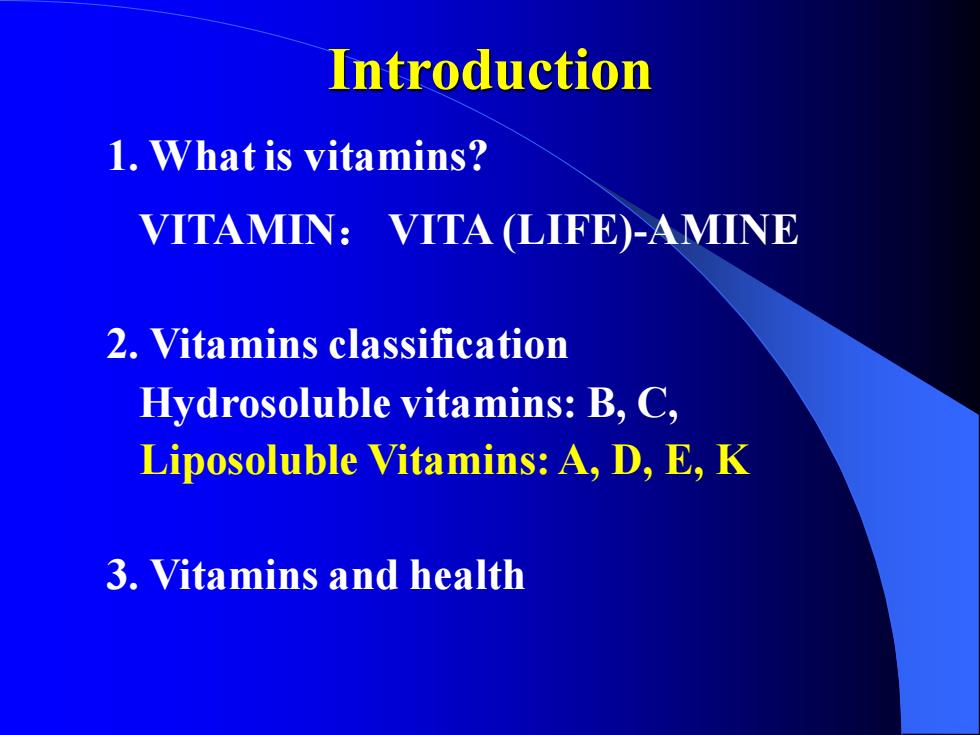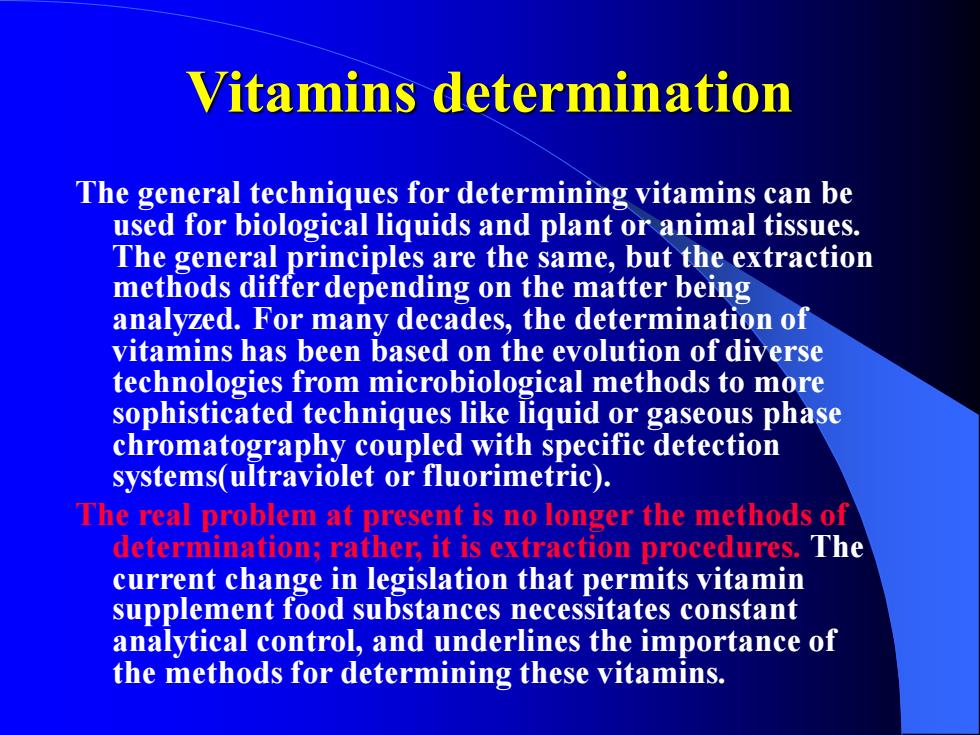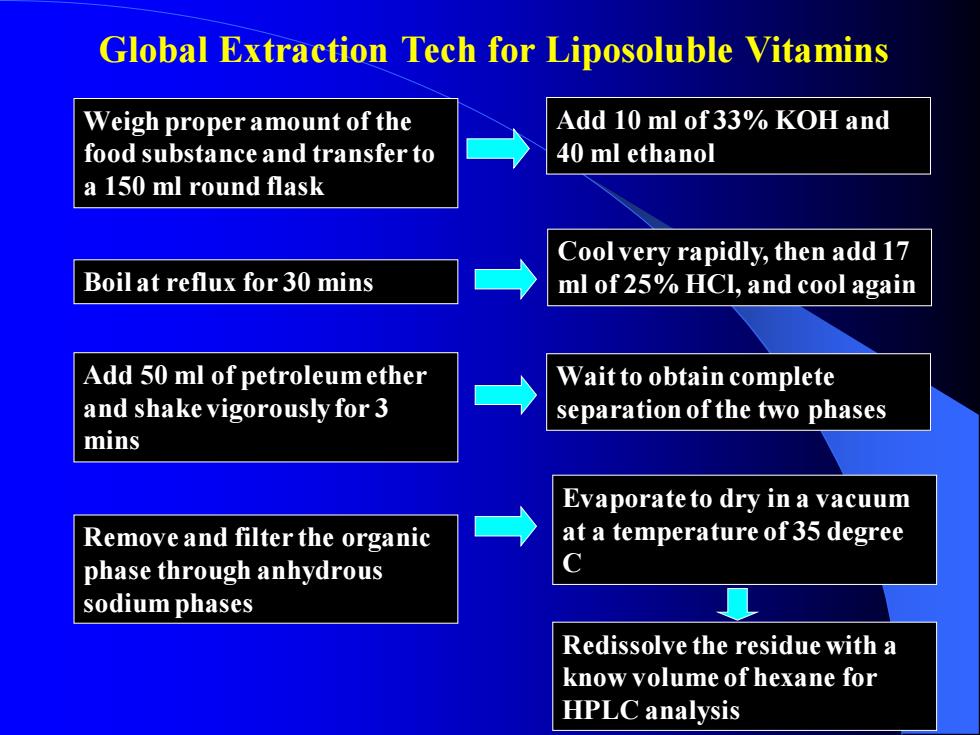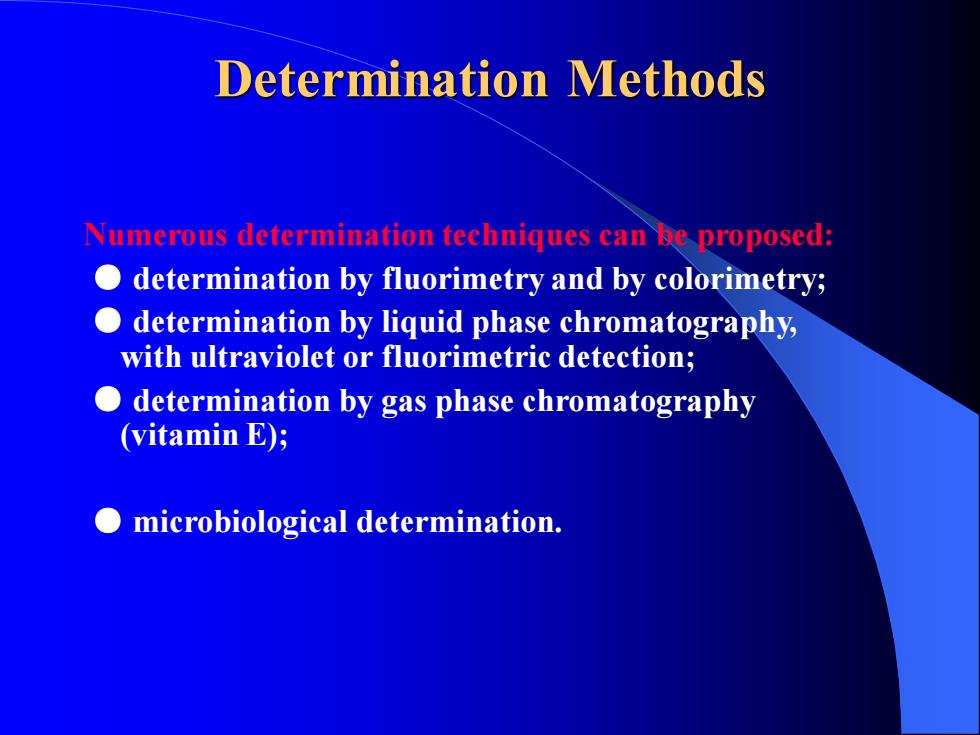
Chapter 11 Vitamins Analysis
Chapter 11 Vitamins Analysis

Introduction 1.What is vitamins? VITAMIN:VITA (LIFE)-AMINE 2.Vitamins classification Hydrosoluble vitamins:B,C, Liposoluble Vitamins:A,D,E,K 3.Vitamins and health
Introduction 1. What is vitamins? VITAMIN:VITA (LIFE)-AMINE 2. Vitamins classification Hydrosoluble vitamins: B, C, Liposoluble Vitamins: A, D, E, K 3. Vitamins and health

Vitamins determination The general techniques for determining vitamins can be used for biological liquids and plant or animal tissues. The general principles are the same,but the extraction methods differ depending on the matter being analyzed.For many decades,the determination of vitamins has been based on the evolution of diverse technologies from microbiological methods to more sophisticated techniques like liquid or gaseous phase chromatography coupled with specific detection systems(ultraviolet or fluorimetric). The real problem at present is no longer the methods of determination;rather,it is extraction procedures.The current change in legislation that permits vitamin supplement food substances necessitates constant analytical control,and underlines the importance of the methods for determining these vitamins
Vitamins determination The general techniques for determining vitamins can be used for biological liquids and plant or animal tissues. The general principles are the same, but the extraction methods differ depending on the matter being analyzed. For many decades, the determination of vitamins has been based on the evolution of diverse technologies from microbiological methods to more sophisticated techniques like liquid or gaseous phase chromatography coupled with specific detection systems(ultraviolet or fluorimetric). The real problem at present is no longer the methods of determination; rather, it is extraction procedures. The current change in legislation that permits vitamin supplement food substances necessitates constant analytical control, and underlines the importance of the methods for determining these vitamins

HC、CH3 CH, CH, H CH2OH CH CH OH CH. VA2 H.O CH, CH, CH CH CH B一胡萝卜素 R3 R2 HO 生育三烯酚 生育酚 H C H● H● H C CH. CH, 麦角固醇 CH HO HO 7 脱氢胆固醇 维生素D3(胆钙化醇)
CH2 CH3 CH3 CH3 CH3 CH2OH CH3 H C CH3 3 CH3 CH3 CH2OH CH3 CH3 CH3 CH3 CH3 CH3 CH3 CH3 H3C CH3 H3C C H3 C H3 HO C H3 C H3 H3C CH3 CH3 HO H3C H3C O CH3 CH3 CH3 CH3 H3C R1 R3 R2 HO O CH3 CH3 CH3 CH3 H3C R1 R3 R2 HO VA1 7-脱氢胆固醇 麦角固醇 生育三烯酚 生育酚 β-胡萝卜素 VA2 维生素D3 (胆钙化醇) H3C CH3 CH3 HO H3C H3C

Global Extraction Tech for Liposoluble Vitamins Weigh proper amount of the Add 10 ml of33%KOH and food substance and transfer to 40 ml ethanol a 150 ml round flask Cool very rapidly,then add 17 Boil at reflux for 30 mins ml of 25%HCI,and cool again Add 50 ml of petroleum ether Wait to obtain complete and shake vigorously for 3 separation of the two phases mins Evaporate to dry in a vacuum Remove and filter the organic at a temperature of 35 degree phase through anhydrous sodium phases Redissolve the residue with a know volume of hexane for HPLC analysis
Global Extraction Tech for Liposoluble Vitamins Weigh proper amount of the food substance and transfer to a 150 ml round flask Redissolve the residue with a know volume of hexane for HPLC analysis Evaporate to dry in a vacuum at a temperature of 35 degree C Remove and filter the organic phase through anhydrous sodium phases Wait to obtain complete separation of the two phases Add 10 ml of 33% KOH and 40 ml ethanol Boil at reflux for 30 mins Cool very rapidly, then add 17 ml of 25% HCl, and cool again Add 50 ml of petroleum ether and shake vigorously for 3 mins

Extraction of Vitamin A 1.Weigh 5-10g of the previously crushed food substance into a 1 L round flask. 2.Add 20 ml of a 50%NaOH solution and warm the mixture in a water bath. 3.Then,add 100 ml of diethyl alcohol and 2 ml of a hydroquinone solution that was obtained by dissolving 20 g in 100 ml of pure alcohol. 4.Maintain the water bath at 90'C for 30 minutes. 5.Pour the contents of the round flask into a decanting vial and add 100 ml of water. 6.Add 50 ml of ethylic ether and shake. 7.Add 50 ml of petroleumether.Shake and allow it to decant. 8.Extract once or twice with 50 ml of petrol ether. 9.Wash the ether phase three times with 100 ml of water. 10.Filter,evaporate,and concentrate until 1 ml is obtained. It must be noted that all of these steps are conducted away from light Moreover,saponification with NaOH is not useful with nonfatty produds
1. Weigh 5-10 g of the previously crushed food substance into a 1 L round flask. 2. Add 20 ml of a 50% NaOH solution and warm the mixture in a water bath. 3. Then, add 100 ml of diethyl alcohol and 2 ml of a hydroquinone solution that was obtained by dissolving 20 g in 100 ml of pure alcohol. 4. Maintain the water bath at 90℃ for 30 minutes. 5. Pour the contents of the round flask into a decanting vial and add 100 ml of water. 6. Add 50 ml of ethylic ether and shake. 7. Add 50 ml of petroleum ether. Shake and allow it to decant. 8. Extract once or twice with 50 ml of petrol ether. 9. Wash the ether phase three times with 100 ml of water. 10. Filter, evaporate, and concentrate until 1 ml is obtained. It must be noted that all of these steps are conducted away from light. Moreover, saponification with NaOH is not useful with nonfatty products. Extraction of Vitamin A

Extraction of Vitamin D2 or D3 1.Weigh between 5 and 10 g of the sample food substance. 2.Add 1 g of pyropanol,90 ml of a mixture of 60 ml absolute ethanol,and 30 ml of a 50%potash solution. 3.Extract three times,each time with 50 ml of petroleum ether. 4.Wash the ether extract and material three times with water. 5.Filter,evaporate,and concentrate until 1 ml is obtained. Saponification with the alcoholic potash mixture is not necessary if the products to be analyzed do not contain fats
1. Weigh between 5 and 10 g of the sample food substance. 2. Add 1 g of pyropanol, 90 ml of a mixture of 60 ml absolute ethanol, and 30 ml of a 50% potash solution. 3. Extract three times, each time with 50 ml of petroleum ether. 4. Wash the ether extract and material three times with water. 5. Filter, evaporate, and concentrate until 1 ml is obtained. Saponification with the alcoholic potash mixture is not necessary if the products to be analyzed do not contain fats. Extraction of Vitamin D2 or D3

Extract of Vitamin E 1.Weigh between 5 and 10 g of the food substance that you cr ush. 2.Add 100 ml of ascorbic acid methanol solution obtained by mixing 0.5 g of ascorbic acid,4 ml of water,and 20 ml ofe thanol brought to 100 ml with methanol. 3.Keep in boiling water for 15-20 minutes. Add 15 ml of a 70%KOH solution Place again in the wa ter bath for 40 minutes. 4.Decant the contents of the flask into a separation flask vial, washing the flask with 50 ml of water. 5.Add 120 ml of ethylic ether and stir the mixture.Decant an d filter on Na2SO4. 6.Extract again with 120 ml of ethyl ether. 7.Filter,evaporate,and concentrate to 1 ml. Saponification with potash is not necessary for nonfat pro ducts
Extract of Vitamin E 1. Weigh between 5 and 10 g of the food substance that you cr ush. 2. Add 100 ml of ascorbic acid methanol solution obtained by mixing 0.5 g of ascorbic acid, 4 ml of water, and 20 ml of e thanol brought to 100 ml with methanol. 3. Keep in boiling water for 15-20 minutes. Add 15 ml of a 70% KOH solution Place again in the wa ter bath for 40 minutes. 4. Decant the contents of the flask into a separation flask vial, washing the flask with 50 ml of water. 5. Add 120 ml of ethylic ether and stir the mixture. Decant an d filter on Na2SO4 . 6. Extract again with 120 ml of ethyl ether. 7. Filter, evaporate, and concentrate to 1 ml. Saponification with potash is not necessary for nonfat pro ducts

Other Extraction Techniques Other Extraction Techniques Specific to Ea ch Liposoluble Vitamin and the Product Bei ng Analyzed These techniques are detailed in the official a nalysis methods proposed by the Official As sociation of Analytical Chemists (OAAC)
Other Extraction Techniques Other Extraction Techniques Specific to Ea ch Liposoluble Vitamin and the Product Bei ng Analyzed These techniques are detailed in the official a nalysis methods proposed by the Official As sociation of Analytical Chemists (OAAC)

Determination Methods Numerous determination techniques can be proposed: O determination by fluorimetry and by colorimetry; O determination by liquid phase chromatography, with ultraviolet or fluorimetric detection; O determination by gas phase chromatography (vitamin E); microbiological determination
Determination Methods Numerous determination techniques can be proposed: ● determination by fluorimetry and by colorimetry; ● determination by liquid phase chromatography, with ultraviolet or fluorimetric detection; ● determination by gas phase chromatography (vitamin E); ● microbiological determination